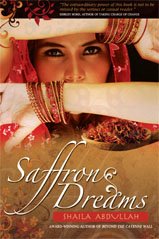 Most of us grew up hearing that reading broadens a person’s perspective. Now a study proves that reading literary fiction like my 2009 book Saffron Dreams can make someone less racist.
Most of us grew up hearing that reading broadens a person’s perspective. Now a study proves that reading literary fiction like my 2009 book Saffron Dreams can make someone less racist.
The study titled Changing Race Boundary Perception by Reading Narrative Fiction led by psychologist Dan Johnson along with a research team from Washington and Lee University appeared in Basic and Applied Social Psychology journal. The study shows that reading a snippet of Saffron Dreams produced two welcome results. Readers were more likely to categorize people as mixed-race, rather than forcing them into specific racial categories. They were also less likely to associate angry faces with disliked outsider groups. Read the remarkable findings at Pacific Standard and Bustle.
Excerpt from the study is below:
Johnson and his colleagues describe two experiments that incorporated a 3,000-word extract from Shaila Abdullah’s 2009 novel Saffron Dreams. It revolves around “an educated and strong-willed Muslim woman, Arissa, who is assaulted in a New York City subway station,” the researchers write. The excerpt features “significant inner monologue that accentuates the protagonist’s strength of character while providing exposure to Muslim culture.”
Participants in the first experiment (68 Americans recruited online) read either the aforementioned excerpt, or a 500-word synopsis of the same scene. In the synopsis, “the descriptive language, monologue, and dialogue were removed to reduce the narrative quality,” the researchers note. They then viewed a series of ambiguous-race faces, and rated them on a four-point scale: (1) Arab, (2) mixed, more Arab than Caucasian, (3) mixed, more Caucasian than Arab, or (4) Caucasian. Those who read the rich, detailed narrative “made significantly fewer categorical race judgments” compared to those who simply read the synopsis. They also “reported significantly higher genetic overlap between Arabs and Caucasians,” which suggested their racial boundary lines were less rigid and distinct.
The second experiment featured 110 people similarly recruited online. They read either the aforementioned excerpt from the novel, the brief synopsis thereof, or an unrelated piece, “a brief history of the automobile.” Afterwards, all examined 12 images of the ambiguous Arab-Caucasian faces “with varying levels of anger expression.” They were instructed to classify them on the same four-point scale. Expressions of high-intensity anger led participants who read either the synopsis, or the history of the car, to “disproportionately categorize faces as Arab,” the researchers report. But this bias was absent among those who read Abdullah’s narrative.
“Narrative fiction offers a rich context in which exposure to out-group culture and (a process of emotional) merging can occur,” the researchers conclude. “Supporting this notion, there is growing evidence that reading a story engages many of the same neural networks involved in empathy.” It all suggests there’s something about well-written, sensitive fiction that draws us in and lets us identify with the characters—even if they’re from a foreign culture. This, in turn, short-circuits our tendency to stereotype.




